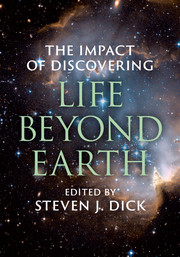Book contents
- Frontmatter
- Dedication
- Contents
- List of contributors
- Introduction: Astrobiology and society
- Part I Motivations and approaches: How do we frame the problems of discovery and impact?
- Part II Transcending anthropocentrism: How do we move beyond our own preconceptions of life, intelligence, and culture?
- 5 The landscape of life
- 6 The landscape of intelligence
- 7 Universal biology: assessing universality from a single example
- 8 Equating culture, civilization, and moral development in imagining extraterrestrial intelligence: anthropocentric assumptions?
- 9 Communicating with the other: Infinity, geometry, and universal math and science
- Part III Philosophical, theological, and moral impact: How do we comprehend the cultural challenges raised by discovery?
- Part IV Practical considerations: how should society prepare for discovery – and non-discovery?
- Contributor biographies
- Index
- References
5 - The landscape of life
from Part II - Transcending anthropocentrism: How do we move beyond our own preconceptions of life, intelligence, and culture?
Published online by Cambridge University Press: 05 November 2015
- Frontmatter
- Dedication
- Contents
- List of contributors
- Introduction: Astrobiology and society
- Part I Motivations and approaches: How do we frame the problems of discovery and impact?
- Part II Transcending anthropocentrism: How do we move beyond our own preconceptions of life, intelligence, and culture?
- 5 The landscape of life
- 6 The landscape of intelligence
- 7 Universal biology: assessing universality from a single example
- 8 Equating culture, civilization, and moral development in imagining extraterrestrial intelligence: anthropocentric assumptions?
- 9 Communicating with the other: Infinity, geometry, and universal math and science
- Part III Philosophical, theological, and moral impact: How do we comprehend the cultural challenges raised by discovery?
- Part IV Practical considerations: how should society prepare for discovery – and non-discovery?
- Contributor biographies
- Index
- References
Summary
Earth is a planet that exhibits an immense biomass and an incredible biodiversity. Yet, the question arises as to whether the diversity as observed on Earth reflects the limits of life or whether life elsewhere in the universe could manifest an even greater diversity. To examine the question further, I review some of the limits of life as observed on Earth and then ask what specific adaptation mechanisms could reasonably occur on other planets and moons to extend the limits of life to environmental conditions usually not found on our planet. As we currently do not have any convincing evidence for the existence of extraterrestrial life, these extensions must remain in the field of scientific speculation. Yet, given the enormous creativity and flexibility exhibited by the organisms we know from our planet, it would be odd if life could not adapt to some of the conditions exhibited on other planets. Thus, my conjecture is that life in the universe would exhibit a much larger variety of forms and functions than life on Earth.
The landscape of life provides important basic information when preparing for the discovery of extraterrestrial life. We are familiar with life on Earth, but life might be so strange on another world that we might not recognize it; especially since there is not even a commonly accepted definition of what life actually is. Thus, it is important to be not too constrained and Earth-centric if we do not want to take the risk to miss it even if an organism is in plain sight. This applies to all life, from microbial to more complex, and also to signals from technologically advanced civilizations. Thus, open-mindedness for this quest is an imperative.
The range of life on Earth
The conditions under which life can persist are incredibly broad; however, the range under which life can originate is likely to be much smaller. Since the origin of life is an unsolved puzzle, I will focus on the persistence of life, particularly under which environmental stresses life exists on Earth. The life most familiar to us, consisting of organisms that live at conditions similar to those we are accustomed to, is generally referred to as mesophilic life. However, during the evolution of life, organisms, particularly microorganisms, conquered nearly all available environmental niches on and within our planetary crust.
- Type
- Chapter
- Information
- The Impact of Discovering Life beyond Earth , pp. 81 - 94Publisher: Cambridge University PressPrint publication year: 2015
References
- 5
- Cited by

